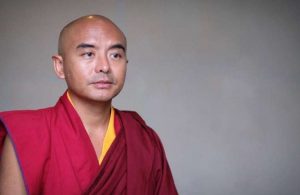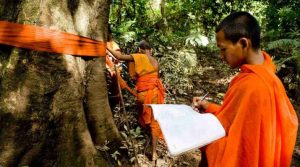
The hike from temple 65, Sankakuji, to temple 66, Unpenji leads the pilgrims through beautiful mountains and forests. At about 900 meters, Unpenji is the highest temple of the pilgrimage route. While Unpenji itself lies in the Tokushima prefecture, most of the hike, once the pilgrims leave Ehime prefecture, runs through Kagawa prefecture. The pilgrims enter Kagwa prefecture for good on their descent to temple 67, Daikōji, also dubbed “pilgrims tumbling down” (henro korogashi 遍路転がし). Regardless of the political prefecture lines, somewhere along the ascent to Unpenji, the pilgrims enter the “dōjō of nirvāṇa.”*
Most people with even some tangential knowledge of Buddhism have heard about the concept of “nirvāṇa.” But what is its significance for the pilgrims after weeks of solitary hiking ready to rejoin the society?
Before I reflect more on the notion and meaning of “nirvāṇa,” I would like to introduce the general feel of this last section of the pilgrimage route. After the pilgrims leave the forest at the foot of Unpenji, they enter the larger urban area of Takamatsu. On this last leg, the pilgrims visit, among others, temple 73, Shussakaji, which commemorates an episode from the childhood of Kūkai. As a seven-year old Kūkai is said to have jumped off Mt. Gahaishi to test whether he should become a monastic and, behold, he was caught by a “heavenly being” (tenjin天神) who set him down on the ground. According to the legend, this experience strengthened Kūkai’s resolve to “leave home” (shukke 出家) and become a monastic. Temple 75, Zentsūji, marks his birth place and temple 84, Yashimaji is located on Mt. Yashima, where the Heike family suffered their decisive—even if not final—loss during the Genpei war (1180-1185). While the pilgrimage route ends at temple 88, Ōkuboji, in the mountains south of Takamatsu, pilgrims are encouraged to visit Mt. Kōya afterwards to officially complete the pilgrimage.
Even though temple 88 itself is located in the mountains, the majority of the pilgrimage route in the “dōjō of nirvāṇa” has a rather urban feel that constitutes an appropriate environment to re-enter society. The feel of re-entry is not only evoked by the pending conclusion of this 4-6 weeks solitary journey. In my last reflection on the pilgrimage,** I mentioned the traditional garb the pilgrims wear. What I did not mention is that it is all white, the color of death. In some sense, pilgrims symbolically “die” to society and enter a different realm, a realm of solitude, of devotion, of detachment, of closeness to spirits, gods, and buddhas and most of all, a realm to focus on “becoming a buddha in this body” (sokushinjōbutsu 即身成仏).*** The white color of the pilgrim garb and gear seems to signal the entry to nirvāṇa, the realm opposite of saṃsāra, the world of suffering, the world of rebirth, the world of karmic causality, and, in some sense, the work-a-day world.
However, most of Mahāyāna Buddhist texts and thought do not construct nirvāṇa as the opposite of saṃsāra. Rather, as Nāgārjuna says, nirvāṇa is “not different from” saṃsāra.**** Moreover, the Heart Sūtra, which the pilgrims chant diligently a minimum of 88 times during the pilgrimage, clearly affirms that there is “no suffering and no end to suffering,”***** a synonym for “no saṃsāra and no nirvāṇa.” This, of course, should not be a surprise to anyone familiar with Mahāyāna Buddhist philosophy. But what does it mean to assert that the fourth of the four dōjōs—following the arousal of the mind, self-cultivation, and “wisdom and enlightenment”—is “nirvāṇa.”
In early Buddhist thought, nirvāṇa identifies the goal of the Buddhist project, the alleviation of suffering. The goal of early Buddhism is to become an arhat, i.e., someone who has attained nirvāṇa. The goal of most of Mahāyāna Buddhism, however, is to become a bodhisattva, i.e. someone who has attained “wisdom and enlightenment”—in Ehime prefecture, so to speak—and then returns to saṃsāra, the place where nirvāṇa is located. This is Mahāyāna Buddhist doctrine.
In the Journey to the West (Saiyūki西遊記), the protagonists Sun Wukong and Tripitaka do not remain in the presence of the Buddha and the arhats in the Pure Land––over the course of the novel Buddha is consistently referred to and evoked as “Amitābha––symbolized by India but return to saṃsāra, the realm of suffering qua “birth, old age, sickness, and death” (shōrōbyōshi生老病死), symbolized by China. It is in China qua saṃsāra that our heroes attain Buddhahood in that novel.
Chapter 2 of the Vimalakīrti Sūtra describes the protagonist of that sūtra as a bodhisattva who lives a nirvāṇic life style in saṃsāra:
He wore the white clothes of a layman, yet lived impeccably like a religious devotee. He lived at home, but remained aloof from the realm of desire, the realm of pure matter, and the immaterial realm. . . . He seemed to eat and drink, yet always took nourishment from the taste of meditation . . . . To demonstrate the evils of desire, he even entered the brothels. To establish drunkards in correct mindfulness, he entered all the cabarets.******
However, I believe that the non-dualism of saṃsāra and nirvāṇa characteristic of Mahāyāna Buddhist philosophy is not limited to the bodhisattva ideal. During the Tang dynasty, Chinese philosopher-monks elaborated on the “philosophy of emptiness” (śūnyatāvāda) introduced above. Zhiyi (538–597), probably the foundational thinker of Tiantai Buddhism, re-imagines the famous assertion of the Heart Sūtra “form is emptiness, emptiness is form” (shiki sokuze kū, kū sokuze shiki 色即是空 空即是色) as a cosmology where the oneness/emptiness of the world, usually imagined by religious thinkers as transcendence, is not different from but manifested in the multiplicity of the empirical world and emphasizes the phrase “one-is-all” (yijieduo 一即多). The Huayan philosopher Chengguan (738–839) further expands this formulation into his famous “fourfold dharma-world” (shifajie 四法界) and proposes the “unobstructed interpretation of all phenomena” (shishiwuai 事事無碍) visualized in the famous image of Indra’s Net (帝釋網).

And now we have come full circle: On the pilgrimage, we manifest the non-duality of nirvāṇa in saṃsāra insofar as we practice attunement of body and mind, self and nature, as well as self and other, ******* the world of the living and the world of the dead, and walk in the modality of “dōgyō ninin” together with Kūkai, the mountain gods/spirits and bodhisattvas––especially Kṣitigarbha, who protects children, travelers, and the dead––our ancestors, the “disappeared,”** and, ultimately, all the living and the dead. On this pilgrimage we realize, in the sense of understanding as well as embodiment, our interconnectedness with all sentient, all living, as well as all existing and non-existing beings. We embody, in Dōgen’s (1200–1253) words, “express,” literally, “attaining the way” (dōtoku 道得), ourselves, all others, “buddhas and patriarchs” (busso 仏祖), and, ultimately, all of Indra’s Net. Dōgen explains:
Now, I and the other engage in liberative practices and enter into a teacher-student dialogue; he and an other engage in liberative practices and enter into a teacher-student dialogue. In me, there is expression and non-expression. In him, there is expression and non-expression. At the bottom of the way, there is self and other; at the bottom of the non-way, there is self and other. *******

The embodiment of this interconnectedness wherein the living, the dead, the disappeared, and all buddhas and patriarchs are expressed constitutes living nirvāṇically in saṃsāra. This was my realization this Summer during my pilgrimage, this is the lesson of Kūkai, this is what it means to live like Vimalakīrti in the 21st century.
* Practice of Attunement: The Shikoku Pilgrimage (BDG)
** Dōgyō ninin: The Shingon Version of “You’ll Never Walk Alone” (BDG)
*** Walking with Kukai–Becoming a Buddha: Pilgrimage in Shingon Buddhism (BDG)
**** Nāgārjuna, Mūlamadhyamakakārikā, chapter 25.
***** Takakusu, Junjirō and Kaigyoku Watanabe, eds. 1961. Taishō shinshū daizōkyō (The Taishō Edition of the Buddhist Canon). Tokyo: Taishō Shinshū Daizōkyō Kankōkai. 220.5.017.
****** Vimalakīrti Sūtra, 20-21
******* Practice of Attunement: The Shikoku Pilgrimage (BDG)
******* Ōkubo, Dōshū, ed. 1969–70. Dōgen zenji zenshū (Complete Works of Zen Master Dōgen). Two volumes. Ed. Tokyo: Chikuma Shobō. [Abbr. DZZ], 1:304.
Related features from BDG
Pilgrimage: Journey to Outer and Inner Landscapes
Pilgrimage: Hongluosi, Home to Priceless Artifacts and Heartwarming Legends
Let there Be Loss
Journey to the Buddha’s Homeland: Rediscovering Pilgrimage Sites in Nepal
Pilgrimage: Mount Jiuhua, Kshitigarbha’s Geopark
From Alena to Yushu, Part 2: Mountain Training
Approaching Nibbana
Eleven Opportunities of Realizing Nibbāna


















